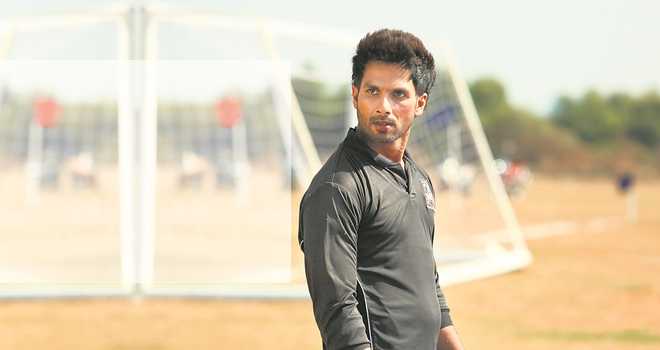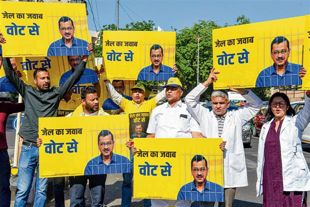
Kabir Singh
Nonika Singh
Audiences are lapping it up; critics are going hoarse in lambasting the latest blockbuster. While makers of Kabir Singh are laughing all the way to the bank, debate over a film has never been more heated.
Chauvinist, misogynist says one side; passionate and intense, claims the other — contradictory words are leaping out and acquiring a sharp edge akin to the lead hero of this Telugu remake. So is the portrayal of Kabir Singh as an obsessed and psychotic lover an aberration of sorts? Hasn’t Indian cinema always thrived on a somewhat similar chauvinist image of lover boy? Isn’t patriarchy a consistent thread when it comes to man-woman romance on our celluloid screen?
Screenplay writer of National Award-winning films like Paan Singh Tomar, Sanjay Chauhan wouldn't say so in these many words. But with the Ramayana and the Mahabharata as our prime sources of story-telling, he can discern a pattern, if not a leitmotif. He says, "Pure, pious and silent lover of yore changed to an expressive lover in the times of the Khan triumvirate."
HE IS THE MAN: Male chauvinism or sexism has always been part of Indian cinema. An analysis of more than 4,000 Hindi films by IBM and two Delhi-based institutions shows portrayal of women on screen has not always been progressive
Indeed, Shah Rukh Khan emerged as the king of romance who made women go weak in their knees and inspired many to follow suit. The romantic lover always put his best foot forward and rarely in the wrong direction, except when he was playing a bad guy in say a Baazigar or a Darr.
With movies like Dilwale Dulhania Le Jayenge and Kuch Kuch Hota Hai, lover as a friend, pyar-dosti-hai template of romance emerged. Many, of course, saw traces of regressive-ness in Kajol's transformation from tomboy to saree-clad woman in Kuch Kuch Hota Hai.
In fact, even its director Karan Johar admitted recently it was indeed regressive of him to indulge in this makeover. Chauhan opines, “Romance in Indian films has been largely conceived from a male point of view. It is more so in South Indian cinema where heroines rarely have a voice.”
Things, however, began to change with films like Jab We Met. In its own way, it set a new benchmark in dynamics of love and passion. For here the male lover, as opposed to woman, was passive and it was the heroine who was the initiator.
With the arrival of a bindaas gal in Tanu Weds Manu and other movies like Dum Laga Ke Haisha one would have assumed the day of mute or submissive heroines and aggressive lovers was over and would be rejected by viewers, now used to the shift in the paradigm.
So what made Kabir, a patronising lover ticking all the wrong boxes, click with viewers? Maybe because we are still stuck on Devdas kind of image in self-destruct mode. The hero drinking himself to death is often perceived as the ultimate height of love, the peerless sacrifice at the altar of love, symptomatic of a passion that knows no bounds. The pining and suffering lover has not only worked in Devdas and its varied versions but in other similar flicks such as Aashiqui 2 as well.
Anurag Singh, director of Punjabi romcoms Jatt and Juliet and its sequel, however, reasons, “Whenever there is something out of the herd mentality and different from the usual scheme of things, it grabs audiences' attention. Cinegoers as viewers are only looking for new concepts and don't even know/understand words like misogyny, especially in India's hinterland.”
Rahul Dahiya, director of socially responsible films such as G Kutta Se, echoes similar sentiments, “Audiences are engaged by a film frame by frame and don't care for social theories. Besides, as people we respond to power; be it a powerful government or dominating lover, we are overwhelmed by the protective dominant trait in those we believe are our protectors.” This reaction, he asserts, is not just true to India but world over. Anurag Singh feels that we are living in times when most of us are full of angst and relate to shows or films like Breaking Bad, Sacred Games, Mirzapur. Kabir Singh is only a natural progression of our changing likes and easily bored state of mind, constantly looking for an adrenaline rush.
It is not as if this darkly intense shade of love has been discovered with Kabir Singh or its original Arjun Reddy alone. Back in time there was Satish Kaushik's Tere Naam and Yash Chopra's Darr. These films, too, projected an obsessive lover driven by the crazed feeling, 'I must have this girl.' Only here the bad guys did not necessarily finish first.
However, stalkers as lovers in movies have won hearts as in Raanjhanaa. Dhanush as the leading man endeared himself to audiences and the movie did fantastic business at the boxoffice. Chauhan reminds us how even in Habib Faisal’s superhit Ishaqzaade, the romance stemmed from a chauvinistic premise. To avenge insult, the hero entices the heroine to sleep with him. Some critics dubbed Ishaqzaade as sexist and felt that despite having a spunky free spirited heroine, she is let down by the writer director and a rather loutish, aggressive hero.
Scriptwriter Kanika Dhillon, who penned the flawed and indecisive lover in an otherwise heroine-oriented Manmarziyaan, however, avers, “Cinema is all about different stories and different characters, their struggles and journeys. Viewing the lead male protagonist simply as a lover boy or judging him on known parameters is reducing the hero to a caricature. Just because one film has thrown up a bad-boy image doesn't mean we are back to dark ages or always were.”
Satish Kaushik though not exactly defending his film Tere Naam, reasons, "It is merely a character which may not be socially correct but is dramatically right."
But yes, insiders do agree that if a formula of any kind succeeds, a few more similar films are likely to follow in attempt to cash on its success. However, to assume that Kabir Singh will become the new normal and impact youth's idea of love is as contentious as the movie is being made out to be. Harjant Gill, associate professor of anthropology in US, who has worked extensively on masculinity, suggests, “Onscreen representations inherently do not have much influence over how we understand ourselves. It is only in the absence of counter-narratives, if these are the only representations that are available to us, that these become impactful.”
But back in time if Salman Khan himself wondered aloud, whether his portrayal of Radhe in Tere Naam would send a wrong signal, it is only fair to question and debate; where Radhes and Kabir Singhs are coming from? For now we can take heart in Kaushik’s words that these onscreen examples of male-centric idea of love are one off ones and not exactly representative icons or even justified behaviour. Only simultaneously we must remember what Johann Wolfgang von Goethe said; “We are shaped and fashioned by what we love.”



























